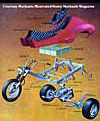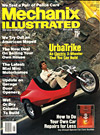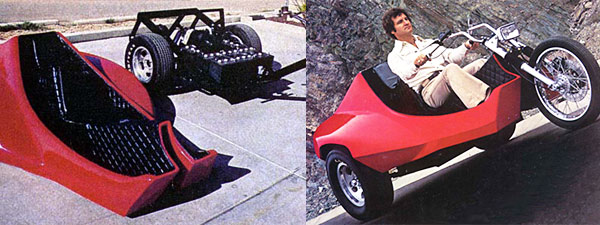|
|
|
|
|
UrbaTrike was years ahead
of its time when
Mechanix Illustrated Magazine featured it on the cover.
![]()
Order Plans Now: - $70
|
UrbaTrike was conceived as a way to put fun and pleasure into the prospect of saving energy and reducing emissions. It's an electric open-bodied trike with seating for two and a range of up to 50 miles on its original 48-volt battery pack. By using today's batteries and controllers, performance can be put on steroids and range can be doubled or even tripled. If you never driven a trike, it's something like a cross between a motorcycle and a wind-in-the-teeth fold-down-windshield sports car. And with UrbaTrike, performance can be tailored to fit your excitement threshold. The prototype shown here is equipped with a modest 48-volt battery pack comprised of eight 6-volt golf car batteries. With this setup, UrbaTrike accelerates from 0 to 35 mph in 9.5 seconds and has a maximum speed of 55 mph - not really wind-in-the-teeth sports car performance. But a 96-volt battery pack (switching to 12-volt batteries, for example) will push top speed to 75-80 mph and double the acceleration rate. Adding additional batteries will give it even more punch. Performance depends on the electrical charge the batteries put behind the motor. The live rear axle can come from just about any rear-wheel-drive car, but ours was from an old Toyota. Virtually any automotive live rear axle will work for UrbaTrike's electric drive. But if you can afford the extra expense, a fully independent rear suspenion can be substituted. The important factor is to keep the track about the same - 54 inches (1370mm). With a wider track, you'd simply extend the fenders to cover the wheels. If you have to deviate from a 54-inch (1370mm) track, go wider, not narrower. The fork is from a Honda 750, but a fork from any large motorcycle will work. The simple frame is made of welded steel tubing and the body is made of FRP/foam composite. Cllick on the prior link to see how it's done. You can see the simplicity of the design in the exploded rendering in the left margin. The frame can be built in a couple of weekends. Figure about 150 hours to build the fiberglass body. As you can see in the photos, there's not much surface area to finish. Plans give complete dimensions and assembly details. Click on the image of the rendering in the left margin to see an exploded view of how UrbaTrike goes together. UrbaTrike plans come with recommendations and sources for modern batteries, motors, and controllers.
|







